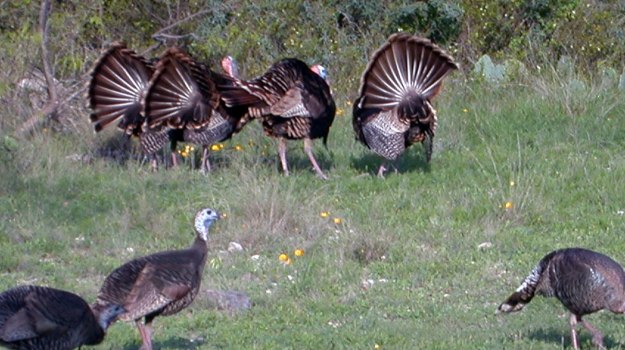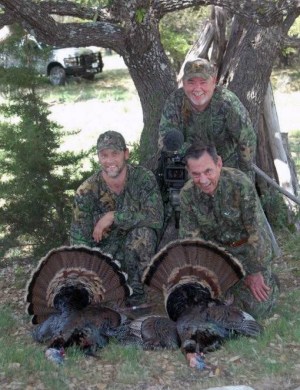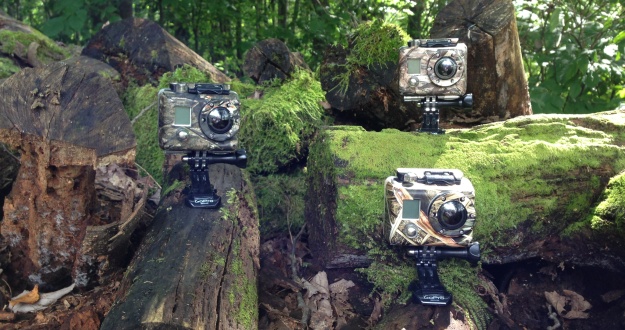with Kevin Burleson

Editor’s Note: Mossy Oak’s Kevin Burleson, one of Mossy Oak’s THUGs, guides at Heart of Texas Bowhunting near Brady, Texas – both bow and shotgun hunters – for turkeys each spring. In Texas, hunters can hunt and take Rio Grande gobblers. If you’ve been hunting eastern wild turkeys all your life, you’ll think you’ve died and gone to heaven, if you have the opportunity to hunt Rio Grandes on a ranch that has plenty of birds like Heart of Texas Bowhunting does. We’ve asked Kevin to tell us some of the major differences between hunting eastern gobblers and Rio Grande turkeys.
I’m often asked, “Tell me what a day of turkey hunting for Rio Grandes is like on the property you hunt.” We start off in the morning going to a place that I know turkeys like to be, after they leave the roost tree. We won’t be going to a specific spot. We just want to get in an area where there’s gobbling turkeys we know we can hunt. While the turkeys are still in the tree, and daylight hasn’t shown up yet, we’ll develop a game plan based on where we think the turkeys will go, when they fly out of the roost. For instance, we may have a small valley that has two or three roost trees in it with plenty of turkeys gobbling. We have to set-up a game plan to try and take advantage of the direction we think the turkeys will fly once the sun comes up. We try to get a gobbler coming to us in that first 30 or 40 minutes after he flies off the roost. We believe this time provides our best chance to be successful. However, there’s one thing about turkeys that you can always depend on – they’re not always dependable.
Often, the hens play a bigger role in determining the outcome of the morning hunt than the gobblers. If several very-aggressive hens are roosting with a flock of gobblers, those hens may pull the majority of the gobblers away from us. Those gobblers will go wherever the hens want them to go. If we don’t take a turkey within that first hour, after the turkeys fly off the roost, we’ll start running and gunning and try to find an active gobbling turkey to work. Many times, when the Rio Grande gobblers fly off the roost, they’ll stay right with a flock of hens and don’t care about our calling. After they’ve been with the hens awhile, they’ll start back calling aggressively – usually about 10:00 am, when the gobblers are breaking away from the hens they’ve flown down with in the morning. Now they’re looking for other hens.
 So from 10:00 am to 12:00 noon, we usually can fire up one or two aggressive gobblers and get them to gobble, and we’ll have a good chance of taking one of those birds. Generally, we come in about 12:00 or 12:30 pm and eat lunch. Then, we start running and gunning for gobblers until dark. We may often jump in the Polaris Ranger, drive to a spot and call, hoping to hear a gobble. If we don’t find a bird at that place, we may go another 1/4- to 1/2-mile and call again. We cover ground until we can find a gobbler that’ll talk to us.
So from 10:00 am to 12:00 noon, we usually can fire up one or two aggressive gobblers and get them to gobble, and we’ll have a good chance of taking one of those birds. Generally, we come in about 12:00 or 12:30 pm and eat lunch. Then, we start running and gunning for gobblers until dark. We may often jump in the Polaris Ranger, drive to a spot and call, hoping to hear a gobble. If we don’t find a bird at that place, we may go another 1/4- to 1/2-mile and call again. We cover ground until we can find a gobbler that’ll talk to us.
Turkey hunting is much like bass fishing. There are some bass fishermen who are looking for that bass that’s ready to bite. Then there’s other bass fishermen who believe they can make any bass bite, whether the fish are hungry or not. They’ll stay in one area, be patient and continue to fish for that bass until they finally catch him. I’m not like this kind of bass fisherman. I like to cover ground and find a turkey that wants to talk right now. If this tactic doesn’t work, then we go to the known travel routes of the turkeys. We’ll sit there and wait until a gobbler comes walking down a trail – which may take 30 minutes or 4 or 5 hours. On these kinds of hunts, we’ll hunt the trails that lead to water in the middle of the day.
Turkeys feed from the time they hit the ground, until they fly back up to the roost. So, they’re feeding all day long. The feeders go off at 7:30 am. Sometimes the turkeys will be going to the feeders before the feeders go off and start slinging out corn, and sometimes the turkeys won’t show up until 9:00 or 10:00 am. We also have feeders that go off at 4:30 pm. Once again, the turkeys may get to the feeder as soon as the feeder goes off, or they may not come in until right at dark. So, if we have to sit on a trail to take a turkey, our hunters may have a long time to sit and wait on the gobbler to show up. Sometimes, the turkeys will come in quickly to the feeder, eat quickly and leave quickly. They very rarely eat all the feed that’s on the ground the first time they come to the feeder in a day. They’ll often come back at other times during the day to get the corn. Feeders do give you a destination that the turkeys like to go to, but you never can be sure when the turkeys will come down the trails to the feeders, and when they won’t. Because we have game cameras on our feeders, we can better predict when the turkeys should show up. However, once again, the turkeys don’t do what they’re supposed to do, when they’re supposed to do it, all the time. Turkeys don’t carry pocket watches. They never know when they’re supposed to be somewhere, and what time they’re supposed to leave a destination. We learned many years ago, when a person tries to tell another person exactly what a wild animal will do, the person who’s supposed to know what a wild animal is supposed to do looks and sounds stupid. You never can know what a wild animal will do every day.
At Heart of Texas Bowhunting Ranch, we also offer 2-day gun hunts also for Rios. We’ll take 50 percent of our gobblers within an hour after they fly down off the roost, 30 percent of our birds between 11:00 am and 2:00 pm and 20 percent of our turkeys after 2:00 pm.
Day 3: Persistence Pays Off When a Rio Grande Turkey Hangs Up
Tomorrow: How to Talk Rio Grande Gobblers with Kevin Burleson



























